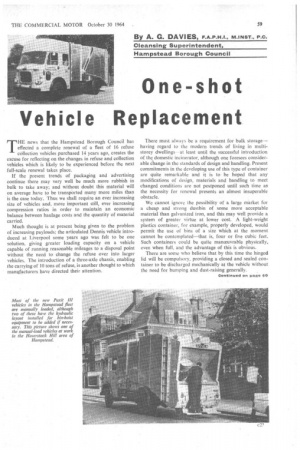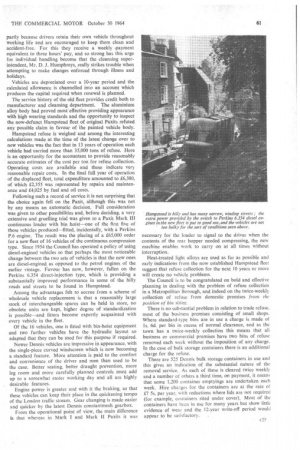One-shot Vehicle Replacement
Page 61

Page 62

Page 63

If you've noticed an error in this article please click here to report it so we can fix it.
THE news that the Hampstead Borough Council has effected a complete renewal of a fleet of 16 refuse collection vehicles purchased 14 years ago, creates the excuse for reflecting on the changes in refuse and collection vehicles which is likely to be experienced before the next full-scale renewal takes place.
If the present trends of packaging and advertising continue there may very well be much more rubbish in bulk to take away; and without doubt this material will on average have to be transported many more miles than is the case today. Thus we shall require an ever increasing size of vehicles and, more important still, ever increasing compression ratios in order to maintain an economic balance between haulage costs and the quantity of material carried.
Much thought is at present being given to the problem of increasing payloads; the articulated Dennis vehicle introduced at Liverpool some years ago was felt to be one solution, giving greater loading capacity on a vehicle capable of running reasonable mileages to a disposal point without the need to change the refuse over into larger vehicles. The introduction of a three-axle chassis, enabling the carrying of 10 tons of refuse, is another thought to which manufacturers have directed their attention. There must always be a requirement for bulk storage— having regard to the modern trends of living in multistorey dwellings—at least until the successful introduction of the domestic incinerator, although one foresees considerable Change in the standards of design and handling. Present commitments in the developing use of this type of container are quite remarkable and it is to be hoped that any modifications of design, materials and handling to meet changed conditions are not postponed until such time as the necessity for renewal presents an almost insuperable obstacle.
We cannot ignore the possibility of a large market for a cheap and strong dustbin of some more acceptable material than galvanized iron, and this may well provide a system of greater virtue at lower cost. A light-weight plastics container, for example, properly developed, would permit the use of bins of a size which at the moment cannot be contemplated—that is, four or five cubic feet. Such containers could be quite rnanceuvrable physically, even when full, and the advantage of this is obvious.
There are some who believe that by this time the hinged lid will be compulsory, providing a closed and sealed container to be discharged mechanically at the vehicle without the need for bumping and dust-raising generally. Concerning the vehicles themselves, it is a confident expectation that drivers will have two-pedal control and power-operated steering, thus approaching the present-day comfort •of driving a private car. With the increasing numbers of motor vehicles in circulation questions of safety become predominant and one cannot visualize drivers having to dO more than_ steer a vehicle and study the traffic situation around them. Anything which brings, about any unnecessary fatigue or distraction will have to be eliminated for safety reasons if nothing else. In the future we are likely to see also an adaptation of radio telephone link in order to deal with large deposits of waste material in the .quickest and most effective (as well as economic) fashion.
Certainly we can expect to find that bulky articles will provide greater and greater headaches; it will not avail to try to shed the problem from our own shoulders. Clearances of this nature will have to be undertaken and everything from old furniture to motorcars will have to find their way to properly organized disposal points. Appropriate vehicles will be necessary for transport.
Thus we cart expect to see large, strongly built machines, with all modern comforts from the point of view of driver and crew, capable of absorbing large objects. There will no doubt be mechanical discharge for larger containers and dustbins.
Apart from the type of material to be collected and the consequent influence on vehicle design, certain characteristics will remain important in the basic concept of vehicle construction. Body weight and capital cost are two of these, and a careful balance will always remain necessary, as between the use of relatively expensive non-ferrous alloys and steel. The alloys hold sway at the present time and it is a matter of conjecture as to whether they will be superseded eventually by anything at least equally satisfactory, and yet offering still further advantage in weight reduction. Almost four years ago, at the Swedish International Cleansing Conference, one large-capacity vehicle constructed almost entirely of glass-fibre was on exhibition, but there would appear to have been little development as yet from the prototype stage.
In our own country vehicle costs are comparatively low, but it will remain necessary to ensure quality construction standards sufficient for the arduous work involved in order that maintenance costs can remain at a reasonable level. This is all the more important in view of the tendency for vehicles to become more complex in operation, with a consequent adverse effect on maintenance costs.
The policy of complete fleet renewal on a given date is something quite foreign to the normal concept of municipal activities. The advantages are fairly obvious, but most local authority representatives on the elected side would boggle at the capital outlay involved. Hampstead Borough Council has, however, performed this operation on two occasions. •
Some 14 years ago the Council disposed of a mixed fleet of vehicles in favour of 16 Dennis Paxit Mark I, delivery of these beginning in September, 1949, with completion of the order within the first month or two in 1950. These 18-cu.-yd, refuse collectors gave fine service to the Council and from an illustration of the veteran vehicles lined us immediately prior to falling out of use one could certainly be forgiven for believing the illustration was one of a new fleet of vehicles. Although bodywork and engines showed evidence of wear consistent with a need for renewal, maintenance standards had been exceptionally high, partly because of the engineering maintenance standards and partly because drivers retain their own vehicle throughout working life and are encouraged to keep them clean and accident-free. For this they receive a weekly payment equivalent to three hours' pay, and so strong has this urge for individual handling become that the cleansing super intendent, Mr. D. J. Humphreys, really strikes trouble when attempting to make changes enforced through illness and holidays.
Vehicles are depreciated over a 10-year period and the calculated allowance is channelled into an account which produces the capital required when renewal is planned.
The service history of the old fleet provides credit both to manufacturer and cleansing department. The aluminium alloy body had proved most 'effective providing appearance with high wearing standards and the opportunity to inspect the now-defunct Hampstead fleet of original Paxits refuted any possible claim in favour of 'the painted vehicle body.
Hampstead refuse is weighed and among the interesting calculations made at the time of the latest change over to new vehicles was the fact that in 13 years of operation each vehicle had carried more than 35,000 tons of refuse. Here is an opportunity-for the accountant to provide reasonably accurate estimates of the cost per ton for refuse collection. Operating costs are Available and these indicate very reasonable repair costs. In the final full year of operation of the displaced fleet, total expenditure amounted to £6,380, of which £2,355 was represented by repairs and maintenance and £4,025 by fuel and oil costs.
Following such a record of service it is not surprising that the choice again fell on the Paxit, although this was not by any means an automatic decision. Full consideration was given to other possibilities and, before deciding, a very extensive and gruelling trial was given to a Paxit Mark III continuous loader with bin hoist—one of the first five of these vehicles produced—fitted, incidentally, with a Perkins P.6 engine. The result was the placing of a £65,000 order for a new fleet of 16 vehicles of the continuous compression type. Since 1954 the Council has operated a policy of using diesel-engined vehicles so that perhaps the most noticeable change between the two sets of vehicles is that the new ones are diesel-engined as opposed to the petrol engines of the earlier vintage. Favour has now, however, fallen on the Perkins 6.354 direct-injection type, which is providing a substantially improved performance in some of the hilly roads and streets to be found in Hampstead.
Among the advantages felt to accrue from a scheme of wholesale vehicle replacement is that a reasonably large stock of interchangeable spares can be held in store, no obsolete units are kept, higher degree of 'standardization is possible—and fitters become expertly acquainted with every vehicle in the fleet.
Of the 16 vehicles, one is fitted with bin-hoist equipment and two further vehicles have the hydraulic layout so adapted that they can be used for this purpose if required.
Newer Dennis vehicles are impressive in appearance, with the single-piece curved windscreen which is now becoming a standard feature. More attention is paid to the comfort and convenience of the driver and men than used to be the case. Better seating, better draught prevention, more leg room and more carefully planned controls must add up to a somewhat easier working day and all are highly desirable features.
Engine power is greater and with it the braking, so that these vehicles can keep their place in the quickening tempo of the London traffic stream. Gear changing is made easier and quicker by the latest Dennis constantmesh gearbox.
From the operational point of view, the main difference is that whereas in Mark I and Mark II Paxits it was necessary for the loader to signal to the driver when the contents of the rear hopper needed compressing, the new machine enables work to carry on at all times without interruption.
Heat-treated light alloys are used as far as possible and early indications from the now established Hampstead fleet suggest that refuse collection for the next 10 years or more will create no vehicle problems.
The Council is to be congratulated on bold and effective planning in dealing with the problem of refuse collection in a Metropolitan Borough, and indeed on the twice-weekly collection of refuse from domestic premises from the position of bin siting.
There is no substantial problem in relation to trade refuse, most of the business premises consisting of small shops. Where standard-type bins are in use a charge is made of Is. 6d, per bin in excess of normal clearance, and as the town has a twice-weekly collection this means that all business or commercial premises have two bins of refuse removed each week without the imposition of any charge. In the case of bulk storage containers there is an additional charge for the refuse.
There are 525 Dennis bulk storage containers in use and this gives an indication of the substantial nature of the removal service. As each of these is cleared twice weekly and a number of others a third time, on payment, it means that some 1,200 container emptyings are undertaken each week. Hire charges for the containers are at the rate of £7 5s. per year, with reductions where lids are not required (for example, containers sited under cover). Most of the containers have been in use for many years but show little evidence of wear and the 12-year write-off period would appear to be satisfactory. .












































































































